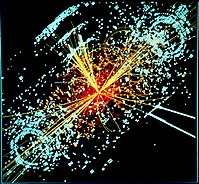
Photo from wikipedia
We present a search for an excess of neutrino interactions due to dark matter in the form of Weakly Interacting Massive Particles (WIMPs) annihilating in the galactic center or halo… Click to show full abstract
We present a search for an excess of neutrino interactions due to dark matter in the form of Weakly Interacting Massive Particles (WIMPs) annihilating in the galactic center or halo based on the data set of Super-Kamiokande-I, -II, -III and -IV taken from 1996 to 2016. We model the neutrino flux, energy, and flavor distributions assuming WIMP self-annihilation is dominant to $\nu \overline{\nu}$, $\mu^+\mu^-$, $b\overline{b}$, or $W^+W^-$. The excess is in comparison to atmospheric neutrino interactions which are modeled in detail and fit to data. Limits on the self-annihilation cross section $\langle \sigma_{A} V \rangle$ are derived for WIMP masses in the range 1 GeV to 10 TeV, reaching as low as $9.6 \times10^{-23}$ cm$^3$ s$^{-1}$ for 5 GeV WIMPs in $b\bar b$ mode and $1.2 \times10^{-24}$ cm$^3$ s$^{-1}$ for 1 GeV WIMPs in $\nu \bar \nu$ mode. The obtained sensitivity of the Super-Kamiokande detector to WIMP masses below several tens of GeV is the best among similar indirect searches to date.
Journal Title: Physical Review D
Year Published: 2020
Link to full text (if available)
Share on Social Media: Sign Up to like & get
recommendations!